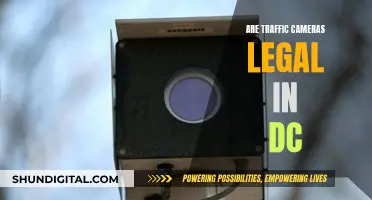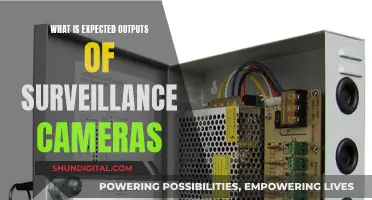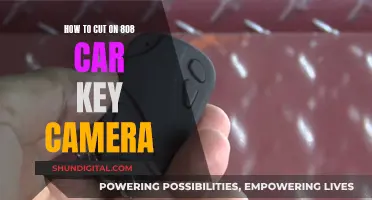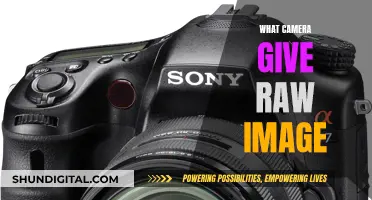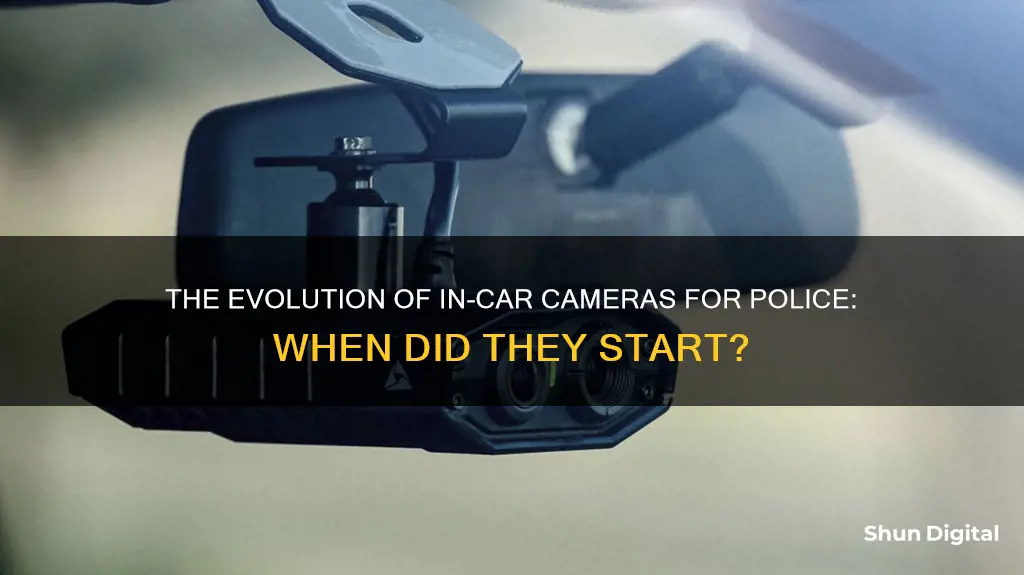
In-car cameras for police, also known as dashcams, have been around for over 25 years. They are onboard cameras that continuously record the view through a vehicle's front windscreen and sometimes rear or other windows. In 2000, only 11% of state police and highway patrol vehicles had in-vehicle camera systems, but now almost 72% of all state patrol vehicles utilize this technology. In-car cameras are triggered by events such as an officer turning on their emergency lights and siren, and can also be manually activated by an officer. They are useful for providing an objective account of what happened during an incident, protecting both officers and citizens.
| Characteristics | Values |
|---|---|
| First use of in-car cameras | Late 1980s |
| Percentage of state police and highway patrol vehicles with in-car cameras in 1999 | 12% |
| Percentage of state police and highway patrol vehicles with in-car cameras in 2000 | 11% |
| Percentage of state patrol cars with in-car cameras today | 72% to 74% |
| Purpose of in-car camera systems | Help preserve an independent, objective record of what the officer encounters; evidence in court; increase accountability by monitoring officer activity |
| Activation of in-car cameras | Can be hardwired into a vehicle's electrical system and triggered by events such as turning on emergency lights and siren; some require officers to manually activate the camera |
| Battery life | Constantly running by using the car battery |
| Benefits of in-car cameras | Provide digital evidence, protect officers and citizens, improve officer training and performance, reduce complaints and false accusations, improve community relations, and lower crime rates |
| Drawbacks of in-car cameras | Large amount of data storage required, potential privacy concerns, and high costs for small departments |
What You'll Learn

In-car cameras have been around for over 25 years
The world of law enforcement has changed a lot in the last 20 years, with technology becoming increasingly ingrained in society. As a result, police departments have seen a surge in new technologies, such as in-car and body cameras, high-tech squad cars, and other devices that keep officers and citizens safe. In-car cameras, in particular, have played a crucial role in this transformation.
One of the biggest benefits of in-car cameras is that they provide an objective account of what happens during a police encounter. This can be extremely valuable in court cases, as it gives judges and juries an accurate picture of the incident. The footage captured by these cameras can also help protect officers from false accusations and complaints, with research showing that 93% of incidents where a complaint is filed against an officer with an in-car camera system, the officer is exonerated.
In addition to improving officer safety and accountability, in-car cameras have also been shown to reduce violence against officers. Offenders are often reluctant to assault officers or become belligerent when they know their actions are being recorded. Furthermore, the presence of in-car cameras can also improve officer courtesy, leading to better community relations.
Another advantage of in-car cameras is their ability to continuously record and provide updates on situations. Many cameras are set to turn on as soon as the car is started, ensuring that every incident is recorded, even if an officer forgets to manually activate the camera. This feature can be especially useful in gathering evidence and improving the efficiency of police work.
Over the years, in-car camera technology has also advanced significantly. Today, most advanced police dash-cam systems record in 1080p or HD settings, providing perfect quality video evidence. Additionally, some in-car camera systems have features such as automatic digital evidence collection and event tags, making it easier for departments to organise thousands of videos.
In conclusion, in-car cameras have been a fixture of law enforcement for over two decades, and their impact has been profound. They have improved the safety and efficiency of police work, strengthened relationships between officers and communities, and provided invaluable evidence for court cases. As technology continues to advance, it's likely that in-car cameras will become even more integral to policing in the years to come.
Cameras Behind Mad Men: Unveiling the Show's Visual Secrets
You may want to see also

They are triggered by events like emergency lights or speeding
In-car police cameras have been in use for over 20 years, with 11% of state police and highway patrol vehicles having them in 2000. Now, almost 72% of all state patrol vehicles use in-car camera technology.
In-car police cameras are hardwired into a vehicle's electrical system, allowing them to be activated by programmed triggers. For example, if a police officer turns on their emergency lights and siren, the camera will automatically start recording. This is a trigger, or an event that prompts the camera system to turn on and start recording. However, not all cameras are triggered in this way, and some require manual activation by an officer.
The Palo Alto police department in California has a camera system that automatically goes into event mode when the red lights on top of the car are on, or when the car goes over 80 miles per hour. Event mode is also triggered if the police car is involved in an accident, or if either back door of the vehicle is opened for a prisoner.
Pro-Vision's police in-car camera systems can be triggered simultaneously with body cameras within a 30-foot range when the vehicle's lights or other triggers are activated. This ensures that both in-car and body-worn footage is captured, providing a more complete view of an incident.
In-car police cameras are an important tool for law enforcement, providing an objective record of incidents, enhancing officer safety, and promoting transparency and accountability.
Surveillance in Subway: Cameras in the Sandwich Shop?
You may want to see also

They can record inside and outside the car
In-car camera systems are now a standard piece of equipment for police departments. They are an essential tool for officers, providing video and audio evidence of incidents and encounters with citizens. One of the key advantages of these systems is their ability to record both inside and outside the police vehicle, offering a comprehensive view of any situation.
The in-car camera systems typically consist of multiple cameras strategically positioned around the car. This includes a front-facing camera on the windshield, a rear-facing camera, and cameras mounted on the sides of the vehicle, often integrated into the light bar. Additionally, there is usually a camera focused on the back seat, where suspects are seated, ensuring they are constantly monitored.
The cameras automatically start recording when the car is turned on, capturing both video and audio. This ensures that every incident, interaction, and conversation is documented. The audio is often linked to the officer's belt, allowing for clear recordings even when the officer is away from the vehicle. The cameras have no battery limitations as they are integrated into the car's electrical system, ensuring uninterrupted recording.
The wide-angle lenses and high-definition video quality of these cameras provide a clear and detailed view of the surroundings. This panoramic view is especially useful in capturing evidence during traffic stops, crime scene investigations, and monitoring the officer's interactions with suspects or citizens. The footage from these cameras offers an objective account of events, protecting officers from false accusations and providing valuable evidence for court proceedings.
The ability to record inside and outside the car enhances the overall effectiveness of the in-car camera system. It not only ensures the safety of officers but also helps maintain the trust and confidence of the community in their local police department.
Trail Camera Technology: How Are They Made?
You may want to see also

They have improved police accountability and public trust
In-car police cameras have been in use since at least 2006, with a steady increase in adoption since then. In 2016, the U.S. Department of Justice reported that about 70% of law enforcement agencies were using dashboard cameras, and this number has continued to grow.
The implementation of in-car camera systems has significantly improved police accountability and public trust. These systems ensure that officers are always recording when needed, providing an accurate and unbiased account of events. The footage can be used for training, court proceedings, and enhancing transparency with the public.
One of the key advantages of in-car cameras is their ability to capture a broad view of the vehicle's surroundings, often including multiple high-definition cameras and high-fidelity audio. This panoramic view provides a more comprehensive record of police encounters, helping to protect officers from frivolous complaints and the public from police impropriety.
The automatic recording feature of in-car cameras ensures that every incident is captured, even if an officer forgets to manually activate the camera. This reduces the guesswork after an incident, as the footage can be reviewed to determine exactly what transpired.
In-car camera systems have been instrumental in resolving complaints and improving transparency. For example, in the case of Scott v. Harris in 2007, dashcam footage was accepted as evidence in the United States Supreme Court, leading to a decision that favoured the officer involved. This demonstrates the power of in-car cameras in providing irrefutable, fact-based evidence that can clear up conflicting testimonies and hold all parties accountable.
The presence of in-car cameras can also act as a deterrent for aggressive behaviour, as individuals are often more compliant when they know they are being recorded. This not only improves officer safety but also helps to de-escalate potentially volatile situations.
In-car camera systems have proven to be a valuable tool for law enforcement agencies, fostering transparency, accountability, and public trust. They provide an objective record of police encounters, protect officers from false accusations, and ensure that police departments can be held accountable for their actions.
Reconnecting Camera Devices: A Simple Computer Hardware Fix
You may want to see also

They are now standard equipment for most police departments
In-car cameras have become standard equipment for most police departments. Over the last two decades, there has been a push for police departments to use in-car-video cameras to record their traffic stops and document race-related encounters. The benefits of these systems far outweigh the costs, and they are now considered to be the most important tool that an officer can have in their car, alongside their weapon.
The majority of police departments now use in-car camera systems, and more and more departments are requiring the use of in-car and body cameras for officers' shifts. In 2000, only 11% of state police and highway patrol vehicles had in-vehicle camera systems, but now almost 72% of all state patrol vehicles utilize this technology.
In-car camera systems are now considered basic equipment for police officers, as important as their sidearms. The cameras are a huge benefit to both the officers and the public, providing independent, objective records of what officers encounter on the job. The recordings are used as evidence in court and can also increase accountability by monitoring officer activity. They protect officers from frivolous complaints and protect the public from officer impropriety. In addition, in-car cameras can help to prove probable cause for search and seizure, often leading to drug money forfeiture.
The technology has also improved significantly since the late 1990s. The most advanced police dash-cam systems now record in 1080p or HD settings, providing perfect-quality video evidence that strengthens police agencies' standing with the communities they serve.
The Evolution of Hasselblad Cameras: A Global Journey
You may want to see also
Frequently asked questions
In-car cameras for police have been in use for over 20 years, with the earliest known example being in 1999 when 12% of state police and highway patrol vehicles were equipped with them.
In-car cameras provide an objective record of what an officer encounters on the job, which can be used as evidence in court and to increase accountability by monitoring officer activity. They also help to protect officers from frivolous complaints and protect the public from officer impropriety.
In-car cameras are typically hardwired into a vehicle's electrical system and can be triggered by events such as an officer turning on their emergency lights and siren. They may also have features like automatic wireless uploading of data when the car returns to the station.


